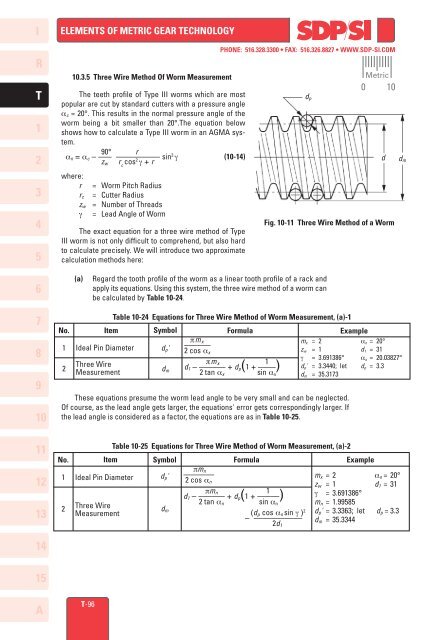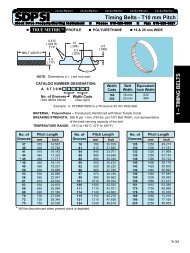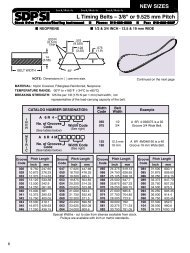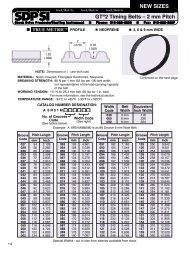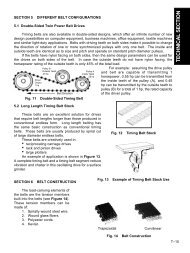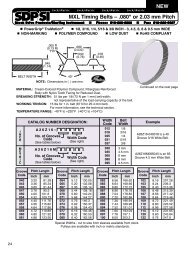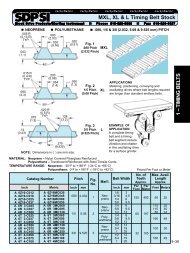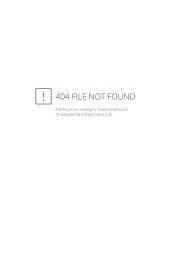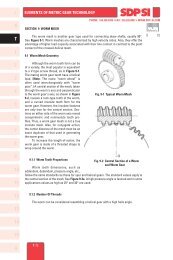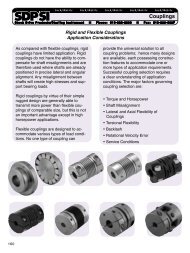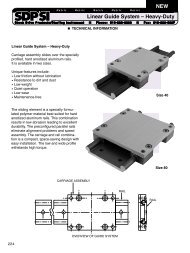I R 1 2 3 4 5 6 7 8 9 10 11 12 13 T 14 15 A
I R 1 2 3 4 5 6 7 8 9 10 11 12 13 T 14 15 A
I R 1 2 3 4 5 6 7 8 9 10 11 12 13 T 14 15 A
You also want an ePaper? Increase the reach of your titles
YUMPU automatically turns print PDFs into web optimized ePapers that Google loves.
I<br />
R<br />
T<br />
1<br />
2<br />
3<br />
4<br />
5<br />
6<br />
7<br />
8<br />
9<br />
<strong>10</strong><br />
<strong>11</strong><br />
<strong>12</strong><br />
<strong>13</strong><br />
<strong>14</strong><br />
<strong>15</strong><br />
A<br />
ELEMENTS OF METRIC GEAR TECHNOLOGY<br />
<strong>10</strong>.3.5 Three Wire Method Of Worm Measurement<br />
The teeth profile of Type III worms which are most<br />
popular are cut by standard cutters with a pressure angle<br />
ac = 20°. This results in the normal pressure angle of the<br />
worm being a bit smaller than 20°.The equation below<br />
shows how to calculate a Type III worm in an AGMA system.<br />
90° r<br />
an = ac – ––– –––––––––– sin3 g (<strong>10</strong>-<strong>14</strong>)<br />
zw r cos c 2 g + r<br />
where:<br />
r = Worm Pitch Radius<br />
rc = Cutter Radius<br />
zw = Number of Threads<br />
g = Lead Angle of Worm<br />
The exact equation for a three wire method of Type<br />
III worm is not only difficult to comprehend, but also hard<br />
to calculate precisely. We will introduce two approximate<br />
calculation methods here:<br />
T-96<br />
PHONE: 516.328.3300 • FAX: 516.326.8827 • WWW.SDP-SI.COM<br />
(a) Regard the tooth profile of the worm as a linear tooth profile of a rack and<br />
apply its equations. Using this system, the three wire method of a worm can<br />
be calculated by Table <strong>10</strong>-24.<br />
dp<br />
Fig. <strong>10</strong>-<strong>11</strong> Three Wire Method of a Worm<br />
Table <strong>10</strong>-24 Equations for Three Wire Method of Worm Measurement, (a)-1<br />
No. Item Symbol<br />
Formula<br />
Example<br />
1<br />
2<br />
Ideal Pin Diameter<br />
Three Wire<br />
Measurement<br />
dp'<br />
dm<br />
pmx<br />
––––––<br />
2 cos ax<br />
pmx 1<br />
d1 – –––––– + dp(1 + ––––)<br />
2 tan ax sin ax<br />
mx = 2<br />
zw = 1<br />
g = 3.69<strong>13</strong>86°<br />
dp' = 3.3440; let<br />
dm = 35.3173<br />
an = 20°<br />
d1 = 31<br />
ax = 20.03827°<br />
dp = 3.3<br />
These equations presume the worm lead angle to be very small and can be neglected.<br />
Of course, as the lead angle gets larger, the equations' error gets correspondingly larger. If<br />
the lead angle is considered as a factor, the equations are as in Table <strong>10</strong>-25.<br />
Table <strong>10</strong>-25 Equations for Three Wire Method of Worm Measurement, (a)-2<br />
No. Item Symbol<br />
Formula<br />
Example<br />
1<br />
2<br />
Ideal Pin Diameter<br />
Three Wire<br />
Measurement<br />
dp'<br />
dm<br />
pmn<br />
–––––––<br />
2 cos an<br />
pmn 1<br />
d1 – –––––– + dp(1 + –––––)<br />
2 tan an sin an<br />
(dp cos an sin g ) 2<br />
– –––––––––––<br />
2d1<br />
Metric<br />
0 <strong>10</strong><br />
mx = 2 an = 20°<br />
zw = 1 d1 = 31<br />
g = 3.69<strong>13</strong>86°<br />
mn = 1.99585<br />
dp' = 3.3363; let dp = 3.3<br />
dm = 35.3344<br />
d<br />
dm


